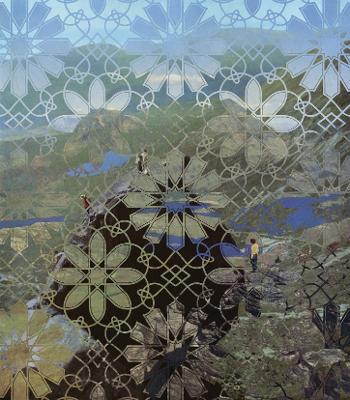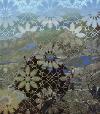New narratives: inclusion and belonging

One element which is common to almost all these historical paintings is that the inhabitants of the pastoral landscapes are white. Landscapes are powerful signifiers of national identity, and most historic art presupposes the nature of both Englishness and Britishness, and more specifically rural Englishness, as exclusively white. Such images conjured up by the art of the past do not remain there, but are strong and pervasive enough to feed into attitudes still current today. The over-arching narrative is one of belonging, and of metaphorical and physical ownership of landscape.
Today this subject is being thought about in new ways and in greater depth, not only in art and literature, but also in broader thinking about who 'belongs' in the countryside and how those norms were established. Barriers to inclusion in the landscape are not always physical: class, gender and race may all act as excluding or marginalising factors.

Henna Nadeem's photographic collages provide a powerful visual embodiment of changing ideas about landscape. She has superimposed patterns from non-European traditions of art onto images from the original Picture Books of Britain series (published by Country Life magazine from 1937-1980s). In X-Rocks, a classic geometric pattern derived from Islamic tilework is laid over a photograph of a mountainous landscape dotted with hikers. Seeming part-translucent, part-opaque, this pattern acts almost like a kaleidoscope. The original image is still there, but a different one is also glimpsed through the combination of the two images. This picture plays with our vision, seeming to shift and change as we look.
Another contemporary artist engaging with issues of belonging is Frances Kearney. Kearney's images combine Romantic, painterly approaches to the landscape and a fascination with the way we inhabit post-industrial and rural environments. Young girls are seen exploring deserted places, both wild and cultivated, which nature seems to have reclaimed.
In unusual locations that are carefully selected, with images immaculately choreographed, the girls are all absorbed in their activities - some mundane, some more mysterious. Far fewer children play outdoors today than in previous generations. By contrast, the solitary girls in Kearney's photographs seem empowered by the spaces they inhabit.

The bold, sweeping horizons portrayed by Turner and Claude suggested limitless distances. Horizons are deeply symbolic. Their emptiness can be intimidating, but they are also positive, giving a sense of boundless freedom and possibility. In facing the horizon, this girl is facing the future, and the unknown. Kearney's work suggests that she is looking towards this future with optimism.











